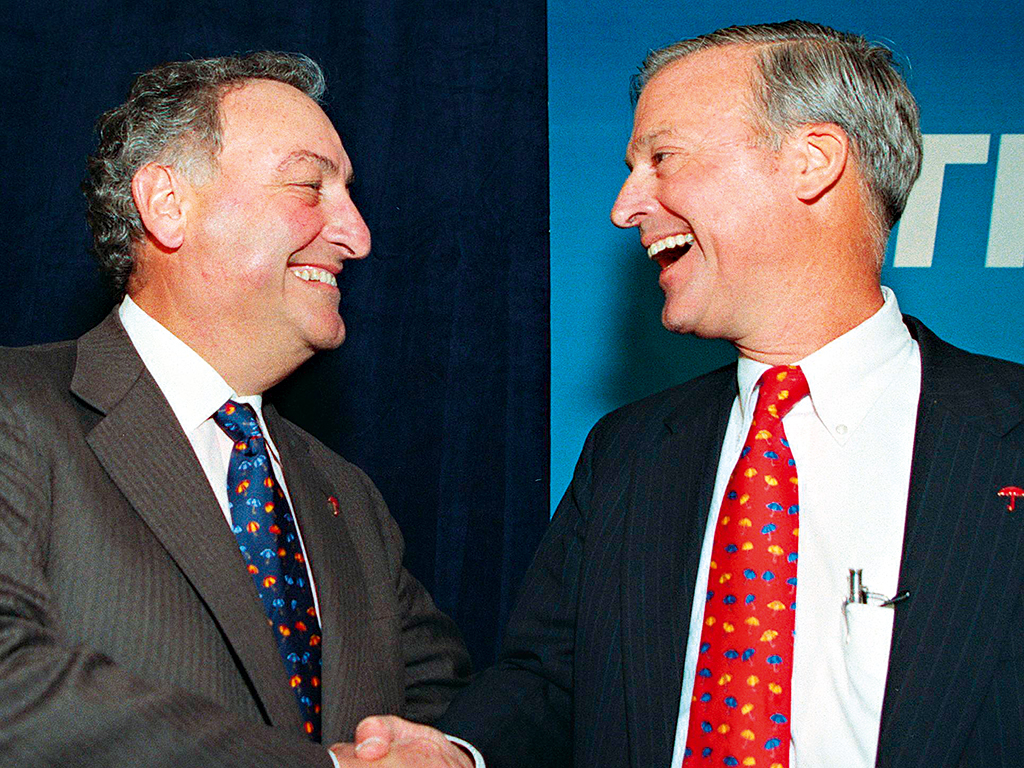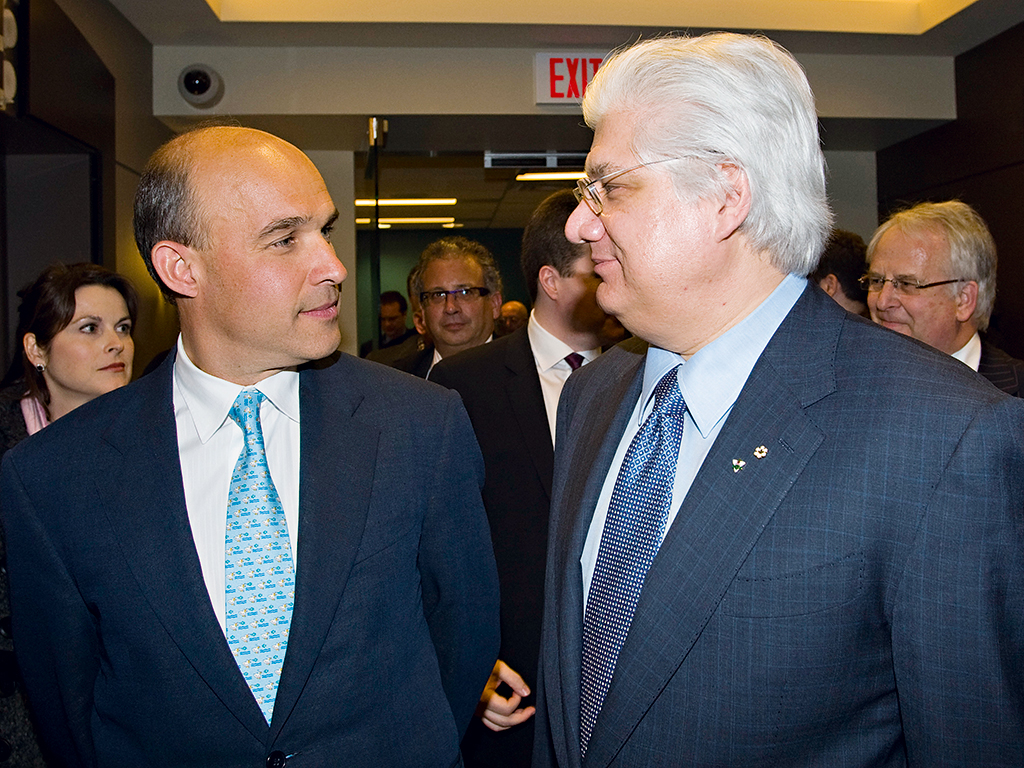
It’s often said that two heads are better than one. And the old adage has recently started drawing decidedly mixed results in the world of business. Over the course of the last decade, there’s been a notable surge in the number of firms integrating multiple CEOs into their corporate governance structures.
The concept isn’t limited to just one industry either. Deutsche Bank, Prada, Chipotle and Wholefoods have all recently joined an ever-increasing club of ‘two-in-the-box’ companies that are driven by multiple executives working side-by-side on the exact same level. Tellingly, a vast majority of those companies are benefitting immensely from the lateral management style. After all, shared leadership undeniably allows for a more dynamic corporate structure in which responsibilities can be shared and delegated, and tough decisions can be scrutinised by more than one set of eyes. But that’s not to say the employment of multiple CEOs is always a godsend.
[E]ven the announcement of shared leadership can provide a boost in the share prices of an
ailing company
It’s incredible how swiftly a dynamic duo can transform into an ugly, two-headed beast when forced to share power. Egos inevitably become inflated when moved into the echelons of upper management – and even when two seasoned and mature executives think they’ve evenly distributed the responsibilities of their shared job, it’s exceedingly difficult for companies to adapt to a divided command structure.
Other board members aren’t always sure who they should be reporting to because of an influx of red tape. Even worse, potential clients often end up confused about exactly who they’re trusting with investments. Firms like Blackberry Limited (formerly Research in Motion) can attest to the detrimental impacts a convoluted governance structure can have on a company’s bottom line. Indeed, not every company possesses the organisation and talent required to succeed under the guidance of multiple CEOs, yet, if implemented correctly, the strategy can harbour colossal benefits.
Better together
Tandem bicycles are difficult to master for the most balanced of pairs. In order to make it from A to B, the contraption requires unparalleled trust, communication and balance. When a couple are able to master all three elements, they’re in for an exceptionally smooth ride.
Take, for example, the rise of global Tex-Mex chain Chipotle. In 1993, Steve Ells founded the company and found great success managing it. Over the course of 15 years, Ells guided the restaurant to become an exceedingly popular US chain that consecutively outperformed its competitors.
So successful was the chain the board began to entertain ambitions of bringing Chipotle to new global markets, and Ells realised there may be a few top-dog decisions he wasn’t 100 percent ready to make. So, at the start of 2009, Ells decided to promote then-president and COO Monty Moran to join him at the head of the table as a co-CEO. The move made perfect sense. Steve Ells was a culinary mastermind by trade, whereas Moran was a seasoned and bloodied lawyer whose negotiation skills were able to land the company with a plethora of new deals and acquisitions. The pair were able to settle into their own dynamic roles as a deal-maker and creative developer, evenly splitting everything in between. By the end of Chipotle’s first year under dual-leadership, earnings had jumped by an incredible 67 percent – and things haven’t slowed down since.
Power of five
More often than not, these sorts of arrangements are sought out of a need to curb falling profits or to counteract bad management practices, rather than a desire for expansion. According to one study by the University of Missouri, even the announcement of shared leadership can provide a boost in the share prices of an ailing company; thus, the system of governance carries immense short-term lift.
Yet two-in-the-box companies are sometimes born out of much more than desperation. The merging of corporate equals, a spin-off into two separate businesses or the twinning of a greying CEO and young heir apparent also pose opportunities for the implementation of a successful dual system. Others still opt for multiple CEOs in order to preserve a level of equality among the co-founders of a firm – and a recent flurry of runaway tech start-ups have begun to stretch this rationale to its absolute limits.
MOBI Wireless Management proves a particularly poignant example. Founded in 2008 by five high school friends, the firm and its sister companies have since risen to become one of the mobile industry’s leading providers of wireless system integration and software – all under the tutelage of five equal CEOs. The arrangement sounds like a costly HR disaster. Quite to the contrary, according to CEOs Scott Kraege, Tony Paris, Josh Garrett and brothers Michael and Christian Browning: governance by rule of five has helped the fledgling firm punch substantially above its weight in a cutthroat industry.
One benefit for MOBI has not only been its unprecedented level of managerial plurality, but also the impossibility of a tied vote on any big decisions. More importantly, however, the structure has brought a wealth of knowledge to the growing firm. Early on, each CEO assumed control over their own area of expertise: IT, marketing, sales, operations and finance. In many regards, that structure conforms to very traditional functional boardroom dynamics. Yet rather than have a number of chief officers reporting to one executive, the five make each decision as a single unit. Enhanced external and internal access to at least one chief executive has also greatly enhanced the firms’ day-to-day operations – allowing better transparency for personnel and potential clients alike. In fact, it was this sort of accessibility that helped the quintet lock down an exclusive distribution deal with telecommunications giant Sprint, which has seen demand for MOBI services skyrocket.

A messy divorce
Not all marriages end in harmony. The co-CEO system of governance is riddled with cautionary tales. When Travelers boss Sandy Weill approached Citigroup CEO John Reed in 1998 proposing a full-fledged union between the two financial firms, Reed was unable to resist. In many ways a merger of equals, the boards of both companies were mashed together, and Reed and Weill agreed to co-exist as equals at the head of the table.
Shares in the company shot sky high. Yet it didn’t take long for fundamental disagreements and heavy egos to get in the way of business. The mismatched personalities kept stalling progress as they bickered over whether to split up the business along customer lines or maintain strength through consolidation. Subordinates were unsure which of the two to approach with propositions, and so a Darwinist power struggle ensued. Reed decided to abandon ship just two years after the merger. In his wake, a continued precedent of muddled leadership kept Citi from integrating its incongruent businesses into one dynamic strategy.
The group eventually lost billions due to poor investment, and had to be bailed out by grudging US taxpayers – and while Citigroup may not have been under dual-control when all hell broke loose, it’s beyond question that the seeds of its destruction were sewn by a clashing of two personalities. Because Citigroup was born from a merger of equals, its two unlike parts depended entirely upon dual leadership in order to provide its thousands of employees with one clear corporate strategy. Above all else, that sort of rift between executives will inevitably doom any two-in-the-box system to failure.
Sub communicate
That being said, clashing egos aren’t the only pitfalls of a dual-CEO structure. Blackberry Limited, for example, didn’t tumble from grace because its two CEOs refused to get along – but rather, because they didn’t communicate.
Founded in 1984 by Mike Lazaridis, RIM was once the cutting-edge mobile firm that defined innovation. In 1992, investor and philanthropist Jim Balsillie was brought on board as co-CEO to help Lazaridis manage the business side of things. The two got along extremely well, and with the help of the company’s award-winning Blackberry design, RIM spent the best part of a decade reigning supreme over an industry it practically invented.
Nevertheless, when competitors like Apple and Samsung finally broke into the smartphone market with new and innovative products, RIM appeared to have hit a creative wall. Concerned board members could rarely get both the company’s two CEOs at the same table in order to talk strategy – and so the company was forced to meander on without one. Creative talent abandoned RIM by the dozen, and neither Lazaridis nor Balsillie appeared to fully recognise that their industry was undergoing a fundamental shift in consumer demand. Further failure to address spates of shoddy service meant a final nail in the coffin for both executives. They quit together in 2012, and were replaced by singular leadership in an attempt to sync the firm under one distinct plan of action.
If the co-CEOs of any given company do not act in unison, there is little room for effective corporate strategy. Communication is key, and clear divisions must be made regarding each person’s workload and responsibilities. Even then, the system is difficult to maintain. After all, shared responsibilities mean shared accountability, therefore, the provision of multiple CEOs can make it difficult for board members to know exactly who should be held liable for mistakes.
Likewise, personnel don’t always have a clear understanding of what should be reported to whom. Even the bosses themselves don’t always know what sort of information must be shared with their colleague. Logic dictates everything of consequence must be agreed upon, but this slows a firm’s ability to make quick decisions in the face of evolving markets and encroaching competition. Business owners are constantly lobbying for governments to remove pesky red tape in order to simplify commerce, and so it hardly makes sense for companies to inflict that same arbitrary monotony upon themselves by implementing reactionary methods of corporate governance.

Toss out the rulebook
For all the strategy’s pitfalls, there’s every reason to indicate the system does work – if only sometimes temporarily. More often than not, analysts agree that plural management has an expiration date. It may be common for two CEOs to share the top job after a merger of equals, for example, but the vast majority of these deals include caveats stipulating one of the two CEOs (usually the oldest) will step down after a certain number of years. In doing so, the new corporate entity is given time to settle under leadership that is familiar to its clients.
Other alternative takes on the co-CEO system include that of global design firm Gensler. The San Francisco-based architectural firm is co-run by CEOs Andy Cohen, Diane Hoskins and David Gensler. Each executive is solely in charge of one aspect of the business; however, in order to keep things running smoothly, the three bosses simultaneously swap roles with each other every three years.
That sort of cross-pollination of expertise helps to preserve relations between the colleagues by keeping egos in check, and also spurs innovation by allowing each boss to experience every aspect of the business first-hand. There appears to be method to the madness too – since 2010, revenues at Gensler have practically doubled.
Like any method of governance, the dual CEO system possesses a number of foreseeable perils. Time and time again, some of the globe’s biggest industrial giants have been led astray by placing too much faith in multiple CEOs. Overinflated egos, a lack of communication and muddled responsibilities have the ability to sink even the most airtight of business models. Few boards relish the idea of splashing out on two or more CEO remuneration packages either, given their high cost.
Notwithstanding, shared leadership can also offer firms an opportunity to catapult a broad range of skills right to the heart of each and every corporate decision. It allows for large firms to be guided by a policy of plurality and diversity, and unearths new business opportunities. If nothing else, boards mulling over the possibility of bringing in a multiple CEO structure should take into consideration that there’s no real rulebook for the strategy. Sometimes it works, sometimes not.
Every firm is unique, and should be treated as such. For those harbouring an interest in joining the two-in-the-box club, corporate management will inevitably pass through a fiery crucible of trial and error. Yet so long as executives are willing to remain flexible, receptive and focused, there’s no reason to believe an alternative CEO structure can’t work.

